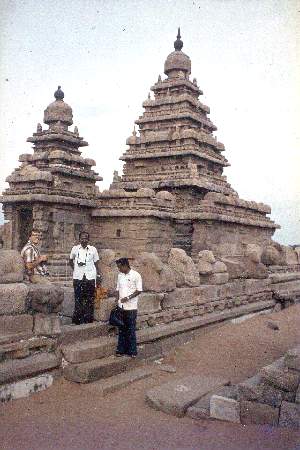

Home | Biodata | Biography | Photo Gallery | Publications | Tributes
Archaeology

 |

Home | Biodata | Biography | Photo Gallery | Publications | Tributes Archaeology |
 |
Most visitors to Mahabalipuram never get around to seeing the stone-carved Saptamatrikas (Seven Mothers) which are placed in a row on a raised platform near the Mahabalipuram Branch Library. Actually, there are eight separate figures in the group. The few guide books which mention these Saptamatrikas consider them all to be Pallava creations. But, in our opinion, seven of them are definitely post-Pallava.
The remarkable exception is the central figure of Chamundi which is considerably larger than the others. What is so rare about this piece? First, it is an image "in the round" datable to the mid-seventh century, A.D. Such a free-standing figure of the Pallava period would be rare enough, but here is one which is just contemporaneous with the Penance Panel and the Five Rathas. There is no other Pallava example of such an early free-standing image of god or goddess known to us.
 Second, even taking the relief images into account, it would seem that this Chamundi is the only example which we have in the south of a Saptamatrika of the seventh
century--the earliest period here of surviving Hindu stone monuments and sculpture. We have to turn to the
eighth century to find the
Saptamatrikas carved in relief on the enclosure wall of the Kailasanatha temple in Kanchipuram.
Second, even taking the relief images into account, it would seem that this Chamundi is the only example which we have in the south of a Saptamatrika of the seventh
century--the earliest period here of surviving Hindu stone monuments and sculpture. We have to turn to the
eighth century to find the
Saptamatrikas carved in relief on the enclosure wall of the Kailasanatha temple in Kanchipuram.
Since Chamundi represents the fearful destroying power of time, the Mahabalipuram image of her has a skull on the centre of her head dress, she has a diabolical grimace with bulging eyes, pointed elf-ears and two fangs protruding downwards from her mouth. The ornament hanging through her pierced right ear-lobe is a miniature corpse (pre$takun@d@ala). She wears diagonally across her body, a garland of severed human heads strung together. There is a thin band tied around her torso above her slightly drooping breasts.
The Mahabalipuram image of Chamundi also has several unusual features which indicate an early experimentation unfettered by the stereotype of later tradition. She holds a dagger in her lower right hand and grips a second corpse in her lower left hand. Originally the figure had four arms, but unfortunately, the upper left one has broken off entirely. Her upper right hand seems to be holding a bell.
What leads us to claim that this is a seventh century Pallava figure? The more obvious characteristics of this early period which we can list in summary form are the very large circular ornament in her left ear (such a large size goes out of fashion by the time of Rajasimha Pallava in the early eighth century); the bikini-like lower garment that she is wearing which has no waist ornaments whatsoever (this extremely simple women's dress, it should be noted, is found only in the earliest period of Mahabalipuram art); the plain, single anklets; and a general slenderness in the treatment of the torso that we connect with the early Pallava style.
Children's slide
Recently the Archaeological Survey had excavated the Pallava rock-cut children's slide, next to the Arjuna's Penance panel. (An article on this 1200-year old slide appeared in The Sunday Standard of April 16, 1972.) From the excavation we see that the slide continues for another three feet below the present ground level. The total length of the slide, therefore, is about nine feet. Five more steps were uncovered by the digging, making a total of 12 steps up to the top of the slide. The bottom of the steps is precisely at the same level as the bottom of the slide.
In the previous article on this ancient children's slide, three questions had been raised. The question about how far below the present ground level it extended, has now been answered (three feet). The second query whether the slide ended in a watery splash in the same pool which received the cascading "Ganga" must now be answered negatively -- the pool level assuming it to have been under the elephants' feet is far below the end of the slide. Finally, the question whether the slide was created for children only, or for the grown-ups too, must (in view of its nine foot length) be decided in favour of children. It is to be hoped that this slide will be used once again by children.